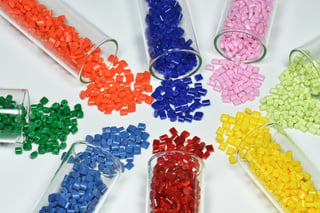Plastic, coming from the Greek “plastikos” meaning “capable of being shaped and molded”: we use it multiple times daily, but what do you know about it? You may be surprised to learn just how advanced plastic is; for example, a fleece jacket can be made from 25 recycled plastic drink bottles. Did you know there are two families of plastics? Thermoplastics and thermosets make up the two families. There are several characteristics of each that differentiate the two. Thermoplastics soften when heated and harden when cooled, can be re-softened and reformed repeatedly, and have a limited upper service temperature. Thermosets harden when heated, cannot be re-softened or reprocessed, and have a high upper service temperature.
Within the family of thermoplastics is four common types of thermoplastics: polyethylene (made from ethylene gas and used for gallon milk jugs, lawn chairs, garbage cans, and disposable gloves), polypropylene (made from propane and other hydrocarbons and used for dishes, automobile parts, and hospital tools), polystyrene (a vinyl compound made from natural plant resins used for bottle caps, blister packages, insulation, and egg cartons), and acrylics (synthetic resins used for contact lenses, windows, and wall paints).
In the family of thermosets are four kinds of thermosets: polyurethane, unsaturated polyesters, phenolics, and silicones. Polyurethane is the extremely tough creation of a reaction between di-isocyanate and organic compounds used in wood coatings, shock absorbers, shoe heels, and refrigerator insulation. The reaction of a polybasic acid and polyhydric alcohol creates unsaturated polyesters. They are used in composite products with extremely high strengths such as boat hulls, automobile bodies, radar domes, and artificial limbs. Phenolics are made from phenol, or carbolic acid, and gaseous formaldehyde and are rigid, strong, temperature resistant. They are found in billiard balls and end panels of toaster ovens. Silicones are used in Silly Putty and gaskets and are made when silicon replaces the carbon element in hydrocarbon.

There are several potential benefits of thermoplastic engineering resins, including a higher part productivity, higher material utilization, greater impact resistance and toughness, thinner wall sections allowing for more compact components, elimination of secondary operations, lower finished part cost, use of plastic welding methods and snap fits, part consolidation, flame retardancy, scrap material can be reprocessed, and good colorability. Along with the benefits come a few potential issues with thermoplastic resins: slightly higher shrinkage, lower service temperature, higher creep, and a greater tendency to arc track.
Engineering plastics offer advantages of thermoplastic materials versus thermosets. These advantages include being a good balance of electrical, thermal, and mechanical properties, it is a better product at a lower cost, there is multifunctional design freedom with thin walls and snap-fits, it has a good design for assembly, and it is a development of new materials and grades.
Plastic affects each and every one of our lives daily, and in some ways most have probably never even thought of. Now that you have a better idea of the two types of families of plastics and the types of each, you also know which types are used for certain types of products we use on a regular, if not daily, basis.


